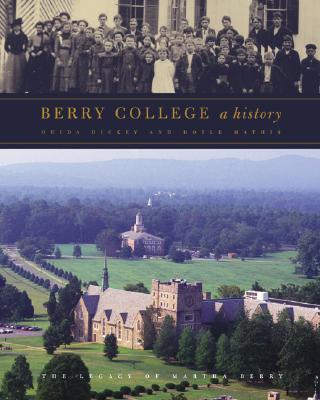Illustrated with more than a hundred photographs, this is the most detailed and comprehensive history to date of Berry College, located in northwest Georgia. Ranging from Berry's modest beginnings in 1902 as a trade school for rural Appalachian youth to its present-day standing among the Southeast's best liberal arts colleges, the book tells how Martha Berry's founding vision--to educate the head, the heart, and the hands--evolved to meet the challenges of each new generation. The photographs, many of them rarely seen before, capture happenings at Berry over its first century: preparations for the world wars, visits by renowned benefactors, student protests, expansions of campus facilities, and diverse aspects of daily life in and out of the classroom.
Parts of Berry's history have achieved legendary status--the story, for example, of how Martha Berry was inspired to start a school after visiting with poor mountain children in her log cabin. Ouida Dickey and Doyle Mathis separate myth from fact as they address Berry's traditions, controversies, and triumphs and relate important developments at Berry to wider events in Georgia and Appalachia. As Berry graduates and career-long members of its faculty and staff, Dickey and Mathis themselves are part of the Berry tradition. Their meticulous research draws on a rich trove of documents to reveal a story that surpasses many of the familiar and beloved tales connected to the school. Berry's enviable standing--as a model for work-study colleges nationwide, as a place intimately tied to the cultural life of its region, as a choice recipient of philanthropy--makes this new book important to historians, scholars of higher education, and thousands of Berry students, faculty, and alumni.
Illustrated with more than a hundred photographs, this is the most detailed and comprehensive history to date of Berry College, located in northwest Georgia. Ranging from Berry's modest beginnings in 1902 as a trade school for rural Appalachian youth to its present-day standing among the Southeast's best liberal arts colleges, the book tells how Martha Berry's founding vision--to educate the head, the heart, and the hands--evolved to meet the challenges of each new generation. The photographs, many of them rarely seen before, capture happenings at Berry over its first century: preparations for the world wars, visits by renowned benefactors, student protests, expansions of campus facilities, and diverse aspects of daily life in and out of the classroom.
Parts of Berry's history have achieved legendary status--the story, for example, of how Martha Berry was inspired to start a school after visiting with poor mountain children in her log cabin. Ouida Dickey and Doyle Mathis separate myth from fact as they address Berry's traditions, controversies, and triumphs and relate important developments at Berry to wider events in Georgia and Appalachia. As Berry graduates and career-long members of its faculty and staff, Dickey and Mathis themselves are part of the Berry tradition. Their meticulous research draws on a rich trove of documents to reveal a story that surpasses many of the familiar and beloved tales connected to the school. Berry's enviable standing--as a model for work-study colleges nationwide, as a place intimately tied to the cultural life of its region, as a choice recipient of philanthropy--makes this new book important to historians, scholars of higher education, and thousands of Berry students, faculty, and alumni.